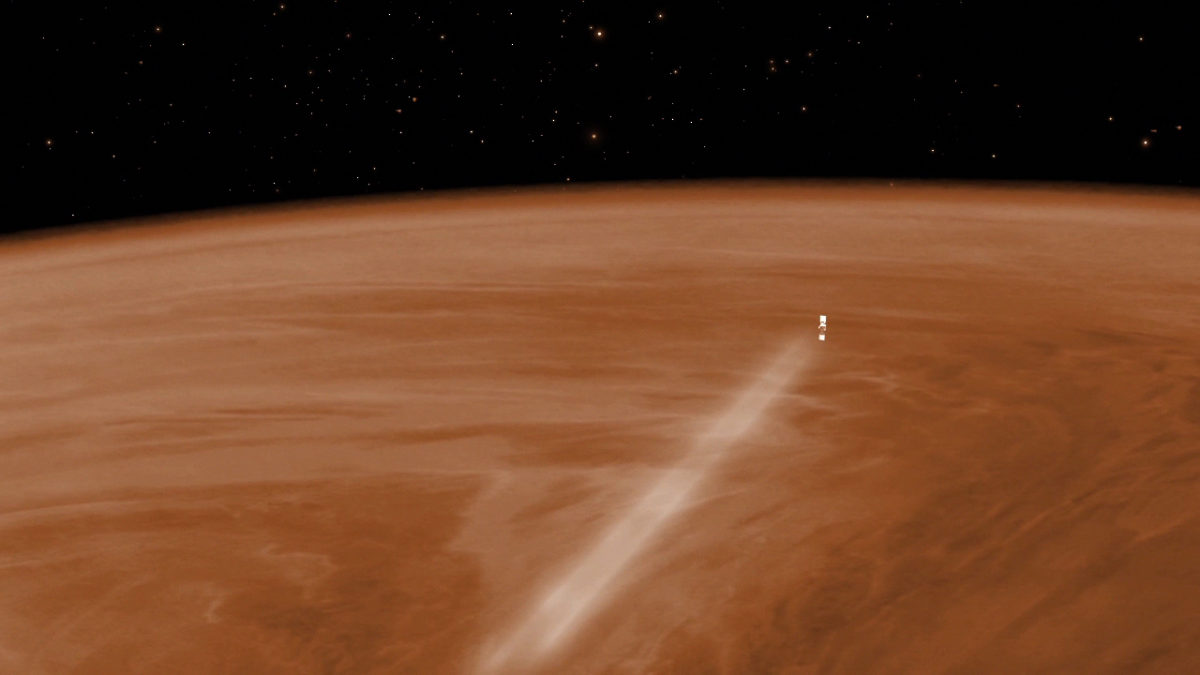Emily Lakdawalla • Nov 24, 2014
Close to the end for Venus Express
Venus Express is nearly out of fuel. Any day could be the last of its long mission to Venus. Formal science operations ended in May, but since then it has performed aerobraking experiments, deep dives into Venus' atmosphere to test whether the atmosphere's effects on the spacecraft match the predictions of its human engineers, who built Venus Express to withstand the forces and temperatures of atmospheric dips. The campaign lasted from May 17 to July 12, when they raised the periapsis (closest approach) of the orbit well above the atmosphere.

According to an article posted on the ESA website a couple of weeks ago, the performance of the spacecraft matched expectations but the performance of Venus didn't. Mission scientists were surprised by the variability of Venus' atmosphere. Venus Express may have detected atmospheric waves, and also saw a surprisingly rapid increase in atmospheric density from the night side to the day side of the planet.
Over time, Venus Express' orbit decays, and by last week the periapsis had got close to 200 kilometers and was falling very rapidly. To keep the mission going, Venus Express must perform periapsis raise maneuvers to keep the orbit from decaying right into the atmosphere. But the spacecraft is running on empty. ESA doesn't know exactly when Venus Express is going to run out of fuel, because it's actually a difficult problem to measure the amount of fuel remaining in a spacecraft fuel tank; most spacecraft fuel "gauges" are actually just bookkeeping of the amount of fuel used over the lifetime of a spacecraft. Small uncertainties in that bookkeeping add up over time, so it's hard to know just how empty the tank is. We're now within the error bars of ESA's estimate of where zero is. But it's not actually at zero yet, because the spacecraft is still successfully performing rocket burns.
The amount of fuel left in the tank is so low that Venus Express can't do its periodic periapsis raise maneuvers all in one burn anymore. Instead, mission controllers separate the burn into 10 or so pulses, each conducted at the orbit apoapsis. Venus Express is in the middle of one such series; it began on Sunday and continues all week. Each day, we could find out Venus Express just isn't there anymore. But it's more likely that engineers have been conservative in their fuel estimates, so there is likely enough fuel remaining to survive this week. The next periapsis raise maneuver is in February, and the subsequent one in June.
As long as Venus Express survives, it'll keep doing science. Venus Express science ground segment manager Don Merritt keeps us updated in the Venus Express thread at unmannedspaceflight.com:
Scientifically, we're using our remaining time on two main issues, both related to volcanism: looking for surface volcanic activity with the infrared channel of our low resolution camera; and looking at atmospheric sulfur dioxide levels. The sulfur dioxide levels in the atmosphere have seen dramatic changes between the previous missions and Venus Express; and the levels are dropping over the lifetime of our mission. So it may be an indication of volcanic activity replenishing sulfur dioxide levels, which then drop. There are other activities, as well.
Here is a poster from the mission operations team (PDF) that summarizes all the minute details of Venus Express' activities in 2015, should it survive to complete them.
Once Venus Express is gone, that may be the end of in-situ Venus science for quite some time, unless Akatsuki manages to achieve Venus orbit insertion using only its reaction control thrusters at the end of next year. Venus Express has lasted longer than anybody had reason to hope. It's time we developed a new Venus mission!
Support our core enterprises
Your support powers our mission to explore worlds, find life, and defend Earth. You make all the difference when you make a gift. Give today!
Donate

 Explore Worlds
Explore Worlds Find Life
Find Life Defend Earth
Defend Earth

